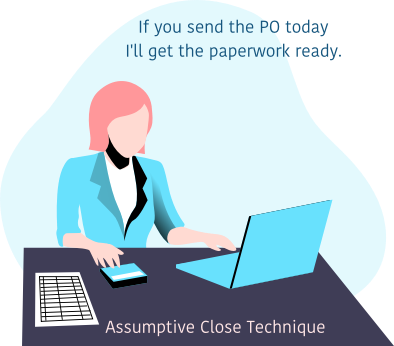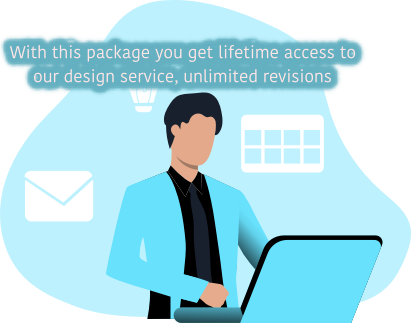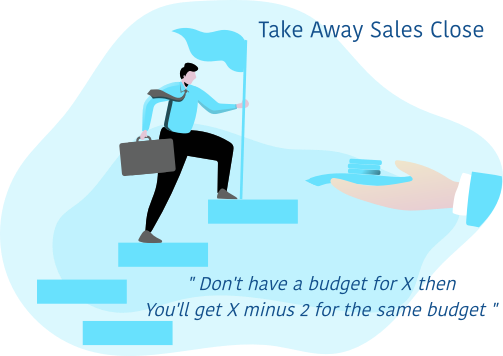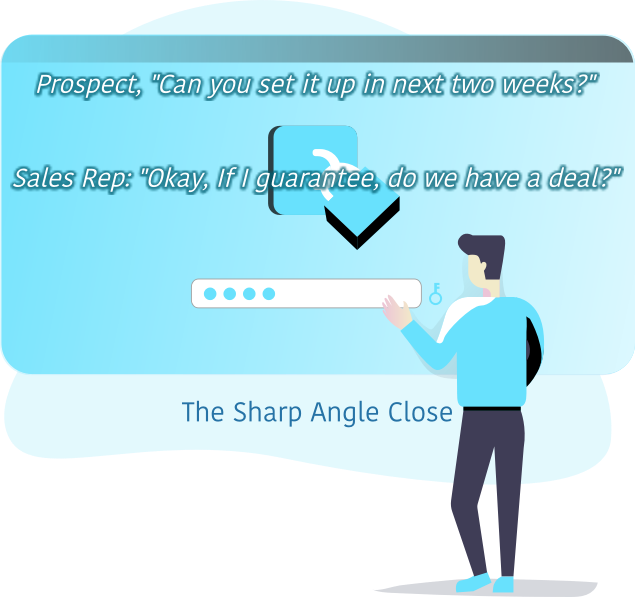We keep hearing about sales success stories[1], some of these are indeed inspiring. Yet pretty often we see stagnated top-lines, sales reps struggling to close deals, worse even losing the business.
So how do you make of these two extremes?
There are reasons why salespeople are not able to close the deals.
And reasons could be
- Perceived lack of trust
- Inability to convince the client about a proposed solution
- Self-centered nature
- Using wrong closing strategy
- Still using the paper sales proposals instead of interactive sales proposals.
- Unable to establish personal connections with prospects
One of the techniques put forward by experts is Incremental Commitment by customers. The idea here is to help customers choose the right solution by making him/her commit a-little-at-a-time. It is hardly about just one pitch and the client is sold.
In today’s information age, clients are informed, selective and cautious. In short, they have become more sophisticated. In reality, one fit for all strategy has never worked before and unlikely to work in the future.
It takes hell lot of time, preparing sales pitches, making presentations, consultation, endless meetings to warm up the prospect. The cost of losing prospects at such a stage is huge. It is not only about loss of business but also about the morale of the sales team, marketing team, engineering team, partners and many other stakeholders.
So what is the secret to close the deal consistently? Frankly, there is no magic wand but persistence and the right approach will definitely improve your chances.
Sales people are aggressive and they follow up endlessly
That’s how sales professionals are perceived. such, generalised notion is not correct.
You don’t believe me?
Let’s look at statistics according to Marketing Donut
- 44 % of salespeople give up after they hear just “NO” from a customer
- 22 % sales reps give up after two “NOs”
- 14 % sales reps give up after three “NOs”
- 12 % sales professionals give up after 4 “NOs”.
I’ve calculated the aggregate ‘give-ups’ and it is whooping 80% (okay, it is 79.122176%, if you are looking for the specific number).
But statistics also say that 80% of the prospects say ‘NO’ four times before they say ‘YES’. And it is one of the reasons, Marketing Donut emphasizes following the “Five Nos” strategy. Five Nos strategy is about holding-on-to-your-ground and face five rejections before you can tick-out or unlists the prospect from your qualified list.
What could be the reasons, customers say no to your offer?
They can be multiple reasons.
- Product does not fit
- Product is great but your company is not fit
- Perception about company – appearance of sales rep, company/product reviews, support, viability, how employees are treated, etc
- Vendor not fulfilling compliance requirement: history, inception, revenue, location, business ranking/grade
- Product is great, company is also fine but there is no budget
- Product is great, company is also fine but timing is not right
If a sales professional gives up in the first step itself, s/he will never realize that few more follow-ups and it could have got the product right, company right, budget right as well as timing also right.
This is exactly why there are proven tactics used to engage and interact with prospects.
What are those tactics?
Those who want to skim through the list, here it is and you will notice the names are self-explanatory.
- The Assumptive Close
- The Summary Close
- The Ben Franklin Close
- The Take Away Close
- The Now or Never Close
- The Objection Close
- The Sharp Angle Close
The Assumptive Close
What is it?
In the Assumptive close technique sales representative deliberately assumes that the deal has been made, the prospect is agreed to buy and makes him/her ready for the purchase. It is more about pushing your product/service to a prospect than giving him/her a choice to think too much about it. In a way, it is a psychological hack.
Tips
- Keep it to the point and convey the decision in terms of benefits prospect is going to enjoy
- No pause, no stop till you get to your secondary question
- Use secondary question (alternate next question that gives two alternatives/ choices but both drive prospect toward making the desired decision) e.g. ‘Can we start tomorrow morning?’. In this case, the positive answer to secondary question means, prospect has agreed to buy/try your offer.
What is the typical approach?
Sales reps make clients feel in the same way and keeping the tone of conversation as if the deal is closed and we are ready to sign the deal formally and start the commercial activities.
When / Why it works?
Sales reps use this tactic when the prospective customer has been qualified through the sales process but has not formally confirmed it.
This technique works because it, kind of pushes prospects to make positive decisions for the offer made. It makes deliberate attempts not to allow the client to spend time to come up with objections thus avoids the client getting cold feet.
When it might not work?
Obviously when your assumptions go wrong 🙂
i.e. when you hurriedly tick-mark your qualifying checklist for prospects, without verifying facts e.g. you might be interacting with end-user but not decision markers; the end user pretending to be decision marker and you did not verify.
The Summary Close
What is it?
In summary close technique – you just need to summarise the benefits to the prospect and explain how s/he and its team will benefit once they buy your product or service. Summary close is about being specific and, to impress them about the value-benefits they are going to buy.
What is the typical approach?
It is like a well-articulated closing speech. Sales rep avoids introducing new facts or angles in the conversation. The sales pitch just has selective points summarising the deal, its benefits and drive the conversation towards closure.
Why it works?
Summary close works effectively when the sales team has gone through in-depth discussions, presentations, evaluation process and sensed that prospect is positively inclined to the purchase/upgrade.
The idea behind summary sales closure is to reinforce the upcoming deal, its benefits. It also repeats what has been already said, presented and agreed. It works to combine pieces of sales discussion happened over the period of time & various meetings and presenting it as a whole/ big picture and get the client to sign the deal.
When it might not work?
If sales rep bring in new perspective, points or facts to the discussion, if prospects drive the discussion and unfolds new areas, concerns, objection, etc. One has to be careful about not being too repetitive with overwhelming details, so much so that it bores the prospect away from your product/ service.
The Ben Franklin Close
What is it?
Benjamin Franklin is one of the founding fathers of the United States of America, he was also widely known as author, scientist, inventor, statesman as well as a diplomat. What many people forget is, he was also a phenomenal businessman who ran the printing business, experimented with many new things. However, whenever it came to making a decision or he had hesitation about doing certain things, he would pen down the pro and cons of the decision.
This sales closing method is about presenting the pros and cons of your product/service with a prospect and convincing him/her by talking about net benefits.
What is the typical approach?
The sales rep lists the pros and cons of the product/service. The list helps prospect check balanced view of the product. Sales rep talks about, pros as well as cons and help prospect realize that pros outweighs cons. At times, the sales rep can showcase, cons do not matter to the prospect. Thus s/he turns prospect’s indecisiveness into a positive direction.
When /Why it works?
There is no rocket science behind this approach but the simplicity and transparency that works wonder in the case of Ben Franklin sales closing technique. This closing technique works well especially for clients who are hesitant to make decisions because of lack of information. When the vendor itself provides product/service assessment (pros and cons), it saves the prospect’s time in research, information assimilation, etc.
It is a bit obvious that as a vendor you will be biased and will show-case more pros than cons. Yet, it is still helpful and makes a better impression that you acknowledge some lacunas, deficiencies, etc.
When it might not work?
There can be situations where you are not able to gain trust of the prospect and s/he will be suspicious of the comparison, tabulation you would present. Also, if your presentation appears to be heavily biased, the prospect will be left unimpressed and more cautious.
The Take Away Close
What is it?
Let’s say your sales team has spent hours working on a deal and in your view, the prospect has almost everything its company needs. But suddenly s/he starts grumbling/complaining and instantly you realize that s/he is trying to bargain. Newbie salesperson will give in and submit to their complaints and do everything just to close the deal.
However seasoned salesman, will not give in. What will s/he do?
Smart sales rep will tactfully inform the prospect that s/he is withdrawing the offer or tweak the offer such that value-added things, premium services will be taken out.
What is the typical approach?
It is like – kid’s candy or toy psychology. If you take candy or toy away from the kid, s/he will want to have it more. And when you threaten to take it away and ask them to behave properly, they usually fall in line.
Similarly, when the prospect is stretching the discussion too much on price or duration or resources; one should
1. Review the overall offered products/ services
2. Decide which features/value-added services can be taken-off from the package and offer it in the same/discounted price.
Now the prospect will think more (or solely) about the features/value-added things getting removed and want to have it (desperately?). The feeling of losing out on those features/value-added things will push him to make the deal.
Why it works?
It is human psychology again. If a person realize that s/he will have to let go of some of the features/value-added things to save money (or resources, etc), s/he just feels like losing the game. Even though the prospect has not paid for anything, s/he would like to be in the game and win it too. The highlight of the Take-away sale closing technique is, ‘the feeling of winning for the prospect’ should remain limited to getting the offer/package back.
This works both ways because
1. For you, the prospect who is simply taking too much time without any justifiable reasons, consuming a lot of your team’s time and exhibiting no significant progress. You are saving your team’s time
2. Also, you can force the prospect to be decisive and take prompt actions
In addition to these, it shows the confidence and conviction you have in your own product/service that you are ready to let go of your prospective client, it’s business within boundaries. Invariably (though the prospect may not like to admit it), It will make the prospect think that s/he will miss out on a great product/service.
When it might not work?
If the prospect is smart enough to understand these tactics (and somehow know you as vendor still want to sell the product/service); s/he can outsmart you. In other cases it may not work, if the prospect perceives as if s/he is cheated for your short term goals (i.e. to just close the deal). So ultimately, for this technique to work, you need to be thoughtful and play it right.
The Now or Never Close
What is it?
Now or Never sales closing technique is pretty old, proven one and is relevant even today. Typically sales rep prepares some sort of impromptu proposition with limited time validity and insist on closing deal ASAP. If the prospect start deliberating and tries to go back and forth, then the sales rep says, “If you don’t want it now, fine! But tomorrow onward the price is going to double up and this offer will not return in future.”
What is the typical approach?
In case of Now or Never Sales closing technique, sales rep promises to offer special benefits to the prospect if s/he acts now. It is effective in all those cases where the prospect is interested, keen but delaying the decision.
When / Why it works?
Now or Never S Technique works because the client is already interested in your product/service offer.
It works because the prospect realises he will miss out the benefits if s/he delay the decision
It works because it generates a sense of urgency
The Sharp Angle Close
What is it?
Sharp Angle sale closing technique is one of the ways to delight your prospect and get him to sign the deal. When prospects discuss discounting pricing, inclusion of value-add things; as a sales rep if you have the right approvals with you, you can surprise the client by agreeing to prospect’s request but asking him/her to sign the deal immediately.
As you can see above, when a prospect asks for a discount or makes a special request; you can take him/her by surprise and say, “Certainly Beth. But if we do that, will you sign the deal now?”
What is the typical approach?
For this approach to work, you need to be prepared, anticipate what the client may ask for, get necessary approvals or arrangements in place. Once your homework is all ready, you are simply waiting for the client to toss this question at you and you can be prompt to respond and close it, right away.
When / Why it works?
It works because,
1. Client wasn’t expecting such response and that too with so promptness
2. You are agreeing to his requests, demands
3. You confidently proposed to close the deal today.
—————————————————————————————————————————————————————————
Subscribe to Proposal Software blog and know about how to write winning proposals, learn about proposal software features, online proposal software benefits.











0 Comments